August 27, 2021 -- Ferments in the Root Cellar
I plan my garden to have fresh corn through late summer/early fall; to
have cabbages ripen in the fall when the root cellar would have started
cooling down so the sauerkraut would ferment nice and slow and last
longer; to have winter squash ripen just as light frosts arrive in the
fall to wilt the leaves and start the fruit curing. Sometimes it even
works out that way! But this year nature took a few different turns.
When we started getting rain toward the end of June (after 6 wks of
abnormal dry heat) the reluctant gardens went into
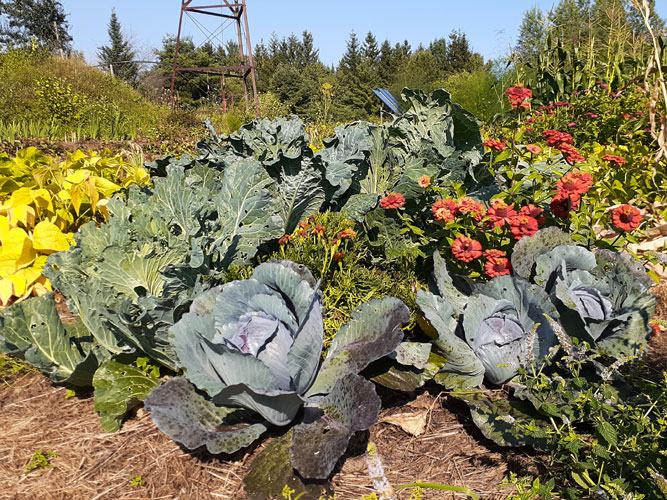 double
time. At the Farmers Market we wondered in amazement at overgrown
cabbages and squash plants, compared tall corn heights - way beyond
"knee high by the 4th of July. And wondered what are we going to do with
winter squash ripening already. Wednesday two vendors had ripe pumpkins
on their tables already. The rain hasn't been overwhelming but the
garden growth is showing great abundance. A summer of 80 degree
temperatures does have some advantages
double
time. At the Farmers Market we wondered in amazement at overgrown
cabbages and squash plants, compared tall corn heights - way beyond
"knee high by the 4th of July. And wondered what are we going to do with
winter squash ripening already. Wednesday two vendors had ripe pumpkins
on their tables already. The rain hasn't been overwhelming but the
garden growth is showing great abundance. A summer of 80 degree
temperatures does have some advantages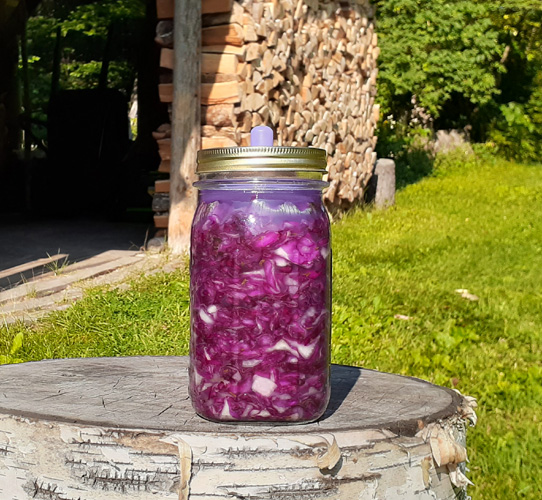 !
It's just something we've not been used to.
!
It's just something we've not been used to.
So this year my two plantings of sweet corn ripened fast and are now
dried and in jars with just a few second ears left for fresh eating. The
first red cabbages wouldn't wait any longer so there are two batches of
beautiful kraut fermenting in the cellar. Thankfully the early green
ones aren't ready yet.
We're eating our first jar of fermented dill pickles so I'll be getting
another jar started soon. Jars of canned vinegar pickles are starting to
fill the shelves. I enjoy fermenting season and we enjoy eating the
results but since we have limited refrigeration space to keep the
finished product I normally depend on the cooler fall root cellar to
keep things from proceeding too fast (we can only eat so much kraut at
one time!). I'm just hoping some coming cooler weather will slow down
the cabbages so I can wait awhile before having to harvest them.
Meantime it appears the winter squash has overdone itself with not only
record large plants but record number of good sized beautiful orange
fruit hidden amongst the big green leaves. They have simply loved the
weather this year. Good thing we like squash.
Even the apples are coming through with a handful of fruit whose
blossoms had escaped the late May freezes. On a year like this with so
little fruit one truly notices and appreciates each and every one that
comes our way.
But lest it sounds like I'm spending all my time in the garden and
kitchen, I'm not. Though I enjoy that time there has also been a lot of
hours spent recreating -- boating, biking (Steve), hiking, walking the
beaches of both Lake Michigan and Lake Superior, and just plain enjoying
being outside in the summer air. We truly are having a beautiful summer
and appreciating it a lot.
November 13, 2019 -- The Last Krauts
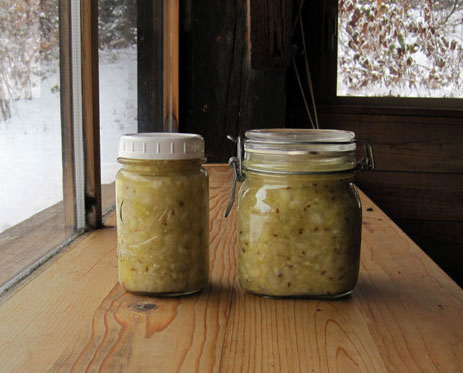 A
blustery, wintery blowing snow day. Though it didn't add very many
inches to the snow on the ground it did keep us from driving north to
play old-time music with friends at Falling Rock Cafe. in Munising.
Since they recently had gotten 20-24 inches we decided to play music at
home instead. But it also seemed like a good day to transfer the most
recent batch of sauerkraut (#4), made two weeks ago, into jars. This one
was made with just green cabbage, some apple and caraway seed. It has a
real nice, mild flavor which I like. It will develop a stronger "kraut"
flavor with time though. We're eating red-green kraut #2 right now (made
end of August) but I dipped into #3, all green, to see how it was doing.
Very nice, mild, gentle texture. The onion flavor I'd noticed earlier
has mellowed and
A
blustery, wintery blowing snow day. Though it didn't add very many
inches to the snow on the ground it did keep us from driving north to
play old-time music with friends at Falling Rock Cafe. in Munising.
Since they recently had gotten 20-24 inches we decided to play music at
home instead. But it also seemed like a good day to transfer the most
recent batch of sauerkraut (#4), made two weeks ago, into jars. This one
was made with just green cabbage, some apple and caraway seed. It has a
real nice, mild flavor which I like. It will develop a stronger "kraut"
flavor with time though. We're eating red-green kraut #2 right now (made
end of August) but I dipped into #3, all green, to see how it was doing.
Very nice, mild, gentle texture. The onion flavor I'd noticed earlier
has mellowed and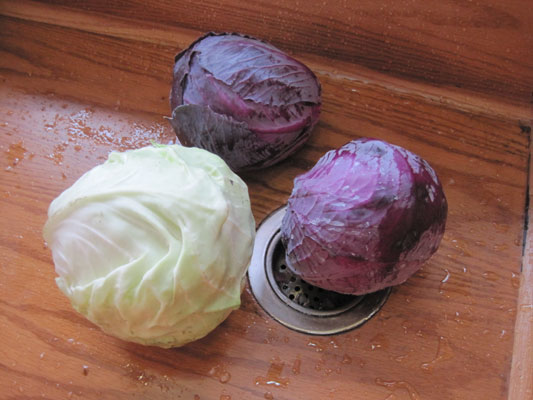 it's very good eaten straight, not mixed in salad or dinner.
it's very good eaten straight, not mixed in salad or dinner.
Since the busy crock was now empty I sliced up the last of the cabbages,
picked a month ago before the temps dropped and stored in the root
cellar. They were all small, two red & one green, but together made a
nice batch of kraut. I decided to again go with just some apple and
caraway seed (and salt, of course). So I think we now have enough
sauerkraut to get us through the winter. Actually, I don't know how long
it will last nor how much we will eat so it will be interesting to see
how that turns out. Meantime we're enjoying the extra taste and crunch
in our salads and additional flavor to potato dishes. The jars are
pretty in the root cellar as well!
September 16, 2019 -- Colorful Sauerkraut
I don't remember the last time I made sauerkraut - it's been many years,
decades really. It's not that we didn't like it; we just didn't eat that
much and that really nice 10 gallon crock that Steve's Mom had given us
so long ago always tempted me to make way more than we needed. So it was
one of those things that just went by the wayside. But this year the
"Fermented Vegetables" book turned my thoughts to sauerkraut once again.
That and some really good homemade kraut we had at a friend's house. So
at the last minute I picked up some seed and planted a row of red and
green cabbages.
They grew well, thankfully at varied rates, and the first of September I
realized a nice head of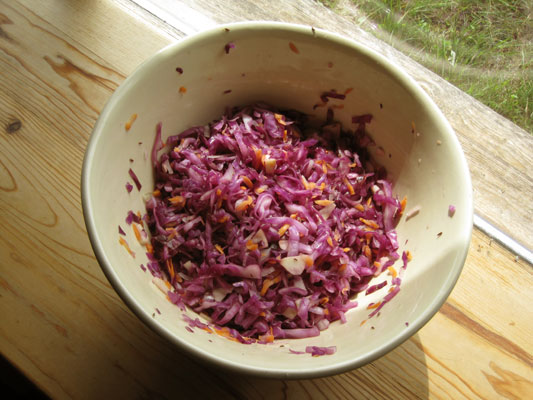 red cabbage was mature and starting to crack. I had a small crock (a
repurposed crockpot that Steve had stripp
red cabbage was mature and starting to crack. I had a small crock (a
repurposed crockpot that Steve had stripp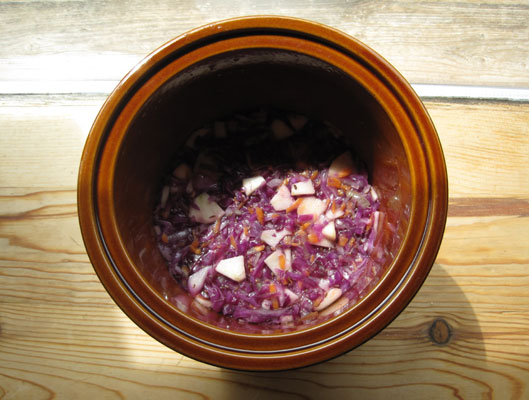 ed
of its outer shell and wire) and I did something I seldom do - I got out
the book and followed their directions and recipe for Red Kraut, with
apple, onion and caraway seed. I also included shredded carrot which
added some nice color to the mix, and we have a lot of carrots this
year. Being a small batch (one 3# cabbage) it didn't take long to slice
and shred and mix. It was particularly satisfying for some reason to get
my (very clean) hands in there and knead in the salt.
ed
of its outer shell and wire) and I did something I seldom do - I got out
the book and followed their directions and recipe for Red Kraut, with
apple, onion and caraway seed. I also included shredded carrot which
added some nice color to the mix, and we have a lot of carrots this
year. Being a small batch (one 3# cabbage) it didn't take long to slice
and shred and mix. It was particularly satisfying for some reason to get
my (very clean) hands in there and knead in the salt.
I let it ferment for two weeks, tasting and checking it now and then and
finally deciding it was ready. It sure turned out pretty! But even
nicer, we liked it, much better than anything I had
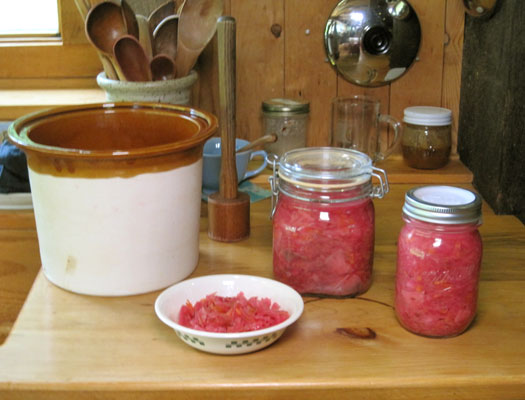 made
before. It adds a particularly nice flavorful crunch to our luncheon
salads.
made
before. It adds a particularly nice flavorful crunch to our luncheon
salads.
The timing was good because just as the crock was emptied and washed
there were three more cabbages mature and ready out in the garden, two
green and one red. So a new batch is fermenting in the root cellar now,
this time with carrot, onion, and fresh oregano. I wonder how it would
be to add some shredded rutabaga to the mix? Mmmm, I can see how one
could get quite carried away with the possibilities. Good thing I only
have one small crock.
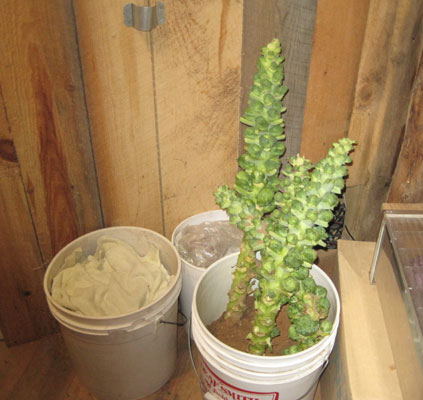
BRUSSELS SPROUTS -- Plant some extra Brussels Sprouts
in the garden and in late fall before
hard winter sets in dig up several plants and 'transplant' them into 5 gal buckets.
Just loosen the roots with a fork, pull up and put them in the pail. Fill over
the roots with damp sand. Set them in a
cool but not freezing cellar or similar place and you can harvest "fresh"
sprouts long after the garden Brussels are frozen solid. Keep the sand damp but
not soggy.
2005 -
2008
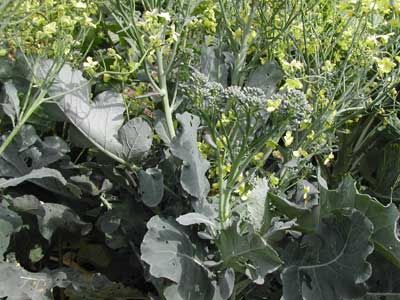 After many, many years of dedication and contentment with the venerable open
pollinated DeCicco Broccoli, I've discovered a new love. Not that there is
anything wrong with DeCicco; it's a very good variety--reliable and it continues
to set many smaller heads/shoots after the main one is harvested. But this year
I discovered Piracicaba (from Fedco Seeds). It's a little earlier than DeCicco,
is larger, and is healthy and productive. But its main joy, for me, is its loose
heads, which makes it easy to spot cabbage worms -- both for me and the birds
(though I find that the birds seldom miss any). It continues to produce after
frosts, and even after it flowers and starts setting seed. Which, unfortunately
for this seed saver, takes a fairly long growing season to mature so my seed
crop is sparse. I keep trying though, in case it is dropped by Fedco. Good
flavor, too, and holds up well after many freezes. I'd hate to lose it.
After many, many years of dedication and contentment with the venerable open
pollinated DeCicco Broccoli, I've discovered a new love. Not that there is
anything wrong with DeCicco; it's a very good variety--reliable and it continues
to set many smaller heads/shoots after the main one is harvested. But this year
I discovered Piracicaba (from Fedco Seeds). It's a little earlier than DeCicco,
is larger, and is healthy and productive. But its main joy, for me, is its loose
heads, which makes it easy to spot cabbage worms -- both for me and the birds
(though I find that the birds seldom miss any). It continues to produce after
frosts, and even after it flowers and starts setting seed. Which, unfortunately
for this seed saver, takes a fairly long growing season to mature so my seed
crop is sparse. I keep trying though, in case it is dropped by Fedco. Good
flavor, too, and holds up well after many freezes. I'd hate to lose it.
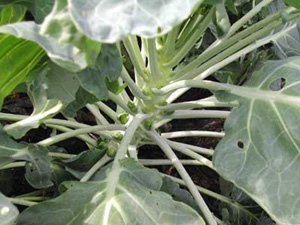 I keep looking for a good, open pollinated Brussels Sprouts and I think I've
found one in Roodnorf. It did a bit better for me than Groninger, which I also
like. The purple Falstaff, though pretty, seldom makes it past the "cute
small sprouts" stage, even when planted earlier. It also doesn't hold up to
freezing very well, so guess I'll stick with the green ones. We don't start
eating the Brussels Sprouts till after the frosts and freezes have set in and
the Broccoli is gone or too whimpy from being frozen, usually in
November/December. I guess you could call it "fresh frozen" food.
The sprouts are easier to snap off when frozen, too, the tiny cabbages just
pop right off.
I keep looking for a good, open pollinated Brussels Sprouts and I think I've
found one in Roodnorf. It did a bit better for me than Groninger, which I also
like. The purple Falstaff, though pretty, seldom makes it past the "cute
small sprouts" stage, even when planted earlier. It also doesn't hold up to
freezing very well, so guess I'll stick with the green ones. We don't start
eating the Brussels Sprouts till after the frosts and freezes have set in and
the Broccoli is gone or too whimpy from being frozen, usually in
November/December. I guess you could call it "fresh frozen" food.
The sprouts are easier to snap off when frozen, too, the tiny cabbages just
pop right off.
It was interesting, in a rather disconcerting and could be worrisome way if I
was apt to give in to worrying (which I avoid) that this summer (2008) we had a
marked decrease in birds around the homestead, and in the garden. It is probably
just the usual, and natural, trend as the number had been increasing to a pretty
good crowd. But fewer birds meant a little less joy and a lot more cabbage
worms. I've always appreciated greatly the birds' contribution to the success,
and ease, in my garden but even more so when they weren't there. The Chipping
Sparrows that did come back, and the others, did a great job as they could but I
certainly had more worm damage than I'd had in years. The interesting thing was,
though, that we had no less of a crop. Though I didn't do anything special. The
Brussels Sprouts leaves sure wouldn't have made it onto the cover of any
gardening magazine, yet I harvested the usual small basket of little heads from
each plant. Maybe there were more nibbles in the sprouts than usual, but nothing
serious. And I had to pick off a few more worms from the Broccoli, which didn't
affect our enjoyment of the many, many meals we were provided. And they went on
to provide a generous array of yellow flowers for late harvest by the many bees.
I found that a few more holes in the leaves didn't seem to bother anyone, including
the plants.
I don't do much with flowers in my garden, but for years I've grown Glads or
Lavatera (what a riot these outrageously pink flowers are!) down the center of
my Cole bed, with a row of Broccoli and/or Brussels Sprouts on either side. They
do well together and are a bright spot in the garden.
2003
BROCCOLI did well this year in spite of the hot, hot July and
August. At least those that made it past the
cutworms (note -- use TALL cardboard collars! These guys simply stood on end and
ate the stems off above my regular collars). And the root maggots. I hadn’t
had that problem for many years and had gotten quite lax about putting wood
ashes around the roots when transplanting, and around the plants thereafter. So,
another note -- use wood ashes! It isn’t as if it’s even that much of a job.
But, how easily we forget past problems.
2001
As might be expected, the BROCCOLI was so-so in the heat, being a cooler weather lover.
Though May was cold and wet, it warmed up in June so things grew well. Then,
after a couple of light frosts the first of July, it turned hot and humid into
August.
But in spite of the weather challenges, the garden provided us with good food. The CABBAGE grew fine and fast, and split fast.
The Marner Allfroh was the worst and much of it ended up in the compost pile.
Primo not only had smaller heads (which suits us better) but split less. Red
Drumhead had little trouble with splitting, with nice small heads as well. The
cabbage worms and loopers loved the weather. I haven’t had that much worm
damage in years. Interesting though, I seldom saw the worms. But the birds were
constantly in the patch (particularly the wonderful Chipping Sparrows). They got
my thanks often, though I know that is not their reason for being there! To
discourage the worms, I tried sage leaves strewn over the plants, but that didn’t
seem to have any affect. Then I tried flour dusted on in the morning dew. That
did seem to help, but was a bit of a mess. The birds were definitely tops for
worm control.
Copyright
© Susan Robishaw
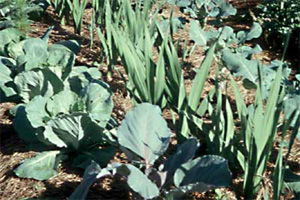



 double
time. At the Farmers Market we wondered in amazement at overgrown
cabbages and squash plants, compared tall corn heights - way beyond
"knee high by the 4th of July. And wondered what are we going to do with
winter squash ripening already. Wednesday two vendors had ripe pumpkins
on their tables already. The rain hasn't been overwhelming but the
garden growth is showing great abundance. A summer of 80 degree
temperatures does have some advantages
double
time. At the Farmers Market we wondered in amazement at overgrown
cabbages and squash plants, compared tall corn heights - way beyond
"knee high by the 4th of July. And wondered what are we going to do with
winter squash ripening already. Wednesday two vendors had ripe pumpkins
on their tables already. The rain hasn't been overwhelming but the
garden growth is showing great abundance. A summer of 80 degree
temperatures does have some advantages !
It's just something we've not been used to.
!
It's just something we've not been used to. A
blustery, wintery blowing snow day. Though it didn't add very many
inches to the snow on the ground it did keep us from driving north to
play old-time music with friends at Falling Rock Cafe. in Munising.
Since they recently had gotten 20-24 inches we decided to play music at
home instead. But it also seemed like a good day to transfer the most
recent batch of sauerkraut (#4), made two weeks ago, into jars. This one
was made with just green cabbage, some apple and caraway seed. It has a
real nice, mild flavor which I like. It will develop a stronger "kraut"
flavor with time though. We're eating red-green kraut #2 right now (made
end of August) but I dipped into #3, all green, to see how it was doing.
Very nice, mild, gentle texture. The onion flavor I'd noticed earlier
has mellowed and
A
blustery, wintery blowing snow day. Though it didn't add very many
inches to the snow on the ground it did keep us from driving north to
play old-time music with friends at Falling Rock Cafe. in Munising.
Since they recently had gotten 20-24 inches we decided to play music at
home instead. But it also seemed like a good day to transfer the most
recent batch of sauerkraut (#4), made two weeks ago, into jars. This one
was made with just green cabbage, some apple and caraway seed. It has a
real nice, mild flavor which I like. It will develop a stronger "kraut"
flavor with time though. We're eating red-green kraut #2 right now (made
end of August) but I dipped into #3, all green, to see how it was doing.
Very nice, mild, gentle texture. The onion flavor I'd noticed earlier
has mellowed and it's very good eaten straight, not mixed in salad or dinner.
it's very good eaten straight, not mixed in salad or dinner. red cabbage was mature and starting to crack. I had a small crock (a
repurposed crockpot that Steve had stripp
red cabbage was mature and starting to crack. I had a small crock (a
repurposed crockpot that Steve had stripp ed
of its outer shell and wire) and I did something I seldom do - I got out
the book and followed their directions and recipe for Red Kraut, with
apple, onion and caraway seed. I also included shredded carrot which
added some nice color to the mix, and we have a lot of carrots this
year. Being a small batch (one 3# cabbage) it didn't take long to slice
and shred and mix. It was particularly satisfying for some reason to get
my (very clean) hands in there and knead in the salt.
ed
of its outer shell and wire) and I did something I seldom do - I got out
the book and followed their directions and recipe for Red Kraut, with
apple, onion and caraway seed. I also included shredded carrot which
added some nice color to the mix, and we have a lot of carrots this
year. Being a small batch (one 3# cabbage) it didn't take long to slice
and shred and mix. It was particularly satisfying for some reason to get
my (very clean) hands in there and knead in the salt.
 made
before. It adds a particularly nice flavorful crunch to our luncheon
salads.
made
before. It adds a particularly nice flavorful crunch to our luncheon
salads.

 After many, many years of dedication and contentment with the venerable open
pollinated DeCicco Broccoli, I've discovered a new love. Not that there is
anything wrong with DeCicco; it's a very good variety--reliable and it continues
to set many smaller heads/shoots after the main one is harvested. But this year
I discovered Piracicaba (from Fedco Seeds). It's a little earlier than DeCicco,
is larger, and is healthy and productive. But its main joy, for me, is its loose
heads, which makes it easy to spot cabbage worms -- both for me and the birds
(though I find that the birds seldom miss any). It continues to produce after
frosts, and even after it flowers and starts setting seed. Which, unfortunately
for this seed saver, takes a fairly long growing season to mature so my seed
crop is sparse. I keep trying though, in case it is dropped by Fedco. Good
flavor, too, and holds up well after many freezes. I'd hate to lose it.
After many, many years of dedication and contentment with the venerable open
pollinated DeCicco Broccoli, I've discovered a new love. Not that there is
anything wrong with DeCicco; it's a very good variety--reliable and it continues
to set many smaller heads/shoots after the main one is harvested. But this year
I discovered Piracicaba (from Fedco Seeds). It's a little earlier than DeCicco,
is larger, and is healthy and productive. But its main joy, for me, is its loose
heads, which makes it easy to spot cabbage worms -- both for me and the birds
(though I find that the birds seldom miss any). It continues to produce after
frosts, and even after it flowers and starts setting seed. Which, unfortunately
for this seed saver, takes a fairly long growing season to mature so my seed
crop is sparse. I keep trying though, in case it is dropped by Fedco. Good
flavor, too, and holds up well after many freezes. I'd hate to lose it. I keep looking for a good, open pollinated Brussels Sprouts and I think I've
found one in Roodnorf. It did a bit better for me than Groninger, which I also
like. The purple Falstaff, though pretty, seldom makes it past the "cute
small sprouts" stage, even when planted earlier. It also doesn't hold up to
freezing very well, so guess I'll stick with the green ones. We don't start
eating the Brussels Sprouts till after the frosts and freezes have set in and
the Broccoli is gone or too whimpy from being frozen, usually in
November/December. I guess you could call it "fresh frozen" food.
The sprouts are easier to snap off when frozen, too, the tiny cabbages just
pop right off.
I keep looking for a good, open pollinated Brussels Sprouts and I think I've
found one in Roodnorf. It did a bit better for me than Groninger, which I also
like. The purple Falstaff, though pretty, seldom makes it past the "cute
small sprouts" stage, even when planted earlier. It also doesn't hold up to
freezing very well, so guess I'll stick with the green ones. We don't start
eating the Brussels Sprouts till after the frosts and freezes have set in and
the Broccoli is gone or too whimpy from being frozen, usually in
November/December. I guess you could call it "fresh frozen" food.
The sprouts are easier to snap off when frozen, too, the tiny cabbages just
pop right off.